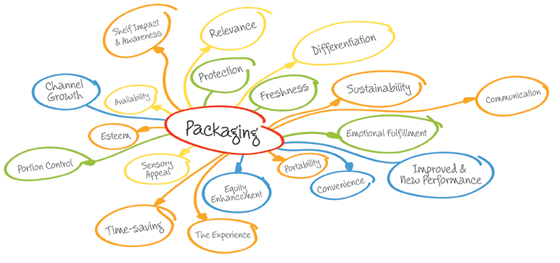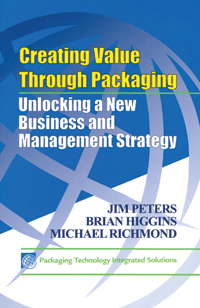The Power of Food Packaging
PACKAGING

Packaging is the “Big P.” Packaging is a strategic foundation for the contained food product.
Packaging adds value to the food product—holistically. Packaging is the enabler, the routing by which product delights the consumer. Packaging is global.
Those are the generic propositions premiered and expounded in a brand new book from consultancy Packaging Technology Integrated Solutions (PTIS), a division of HAVI Global Solutions. The obvious subset for those of us in food science and food packaging technology is that food packaging is a vibrant, vital driver that underlies the delivery of mankind’s source of nutrition.
We anticipate that the essence of Creating Value Through Packaging: Unlocking a New Business and Management Strategy will become an indispensable component of thinking among consumer packaged goods’ (CPG) management, packaging professionals, and marketing executives. Co-authors Jim Peters, Mike Richmond, and Brian Higgins have extended their organizational business models into the thesis that packaging is no longer just a technical mechanism to protect the product from farm to table and even beyond. Although food packaging is additionally a means to communicate, provide convenience, and facilitate distribution, its role for today’s consumers drills deeper into psychographics, ethnography, social media, and even neurology.
 Self-published (www.ptisglobal.com) and produced by DEStech Publications, this smallish paperback snaps the food packaging technologist back from the purely technical objectives, the marketer from the fuzzy front end, and the graphic/structural designer from the artistic reaches. Food packaging in 2013 is transitioning, according to the authorship triumvirate, into a vibrant and indispensable holistic universe that inextricably links the consumer and the source. Richmond, Vice President, Consulting Services for PTIS/HAVI, is a member of the Packaging Hall of Fame and the 2012 Aaron Brody Distinguished Food Packaging Lecturer at Michigan State University. He and PTIS partners Brian Wagner and Phil McKiernan have urged on us a new perspective on the use of packaging for the food communities that it serves.
Self-published (www.ptisglobal.com) and produced by DEStech Publications, this smallish paperback snaps the food packaging technologist back from the purely technical objectives, the marketer from the fuzzy front end, and the graphic/structural designer from the artistic reaches. Food packaging in 2013 is transitioning, according to the authorship triumvirate, into a vibrant and indispensable holistic universe that inextricably links the consumer and the source. Richmond, Vice President, Consulting Services for PTIS/HAVI, is a member of the Packaging Hall of Fame and the 2012 Aaron Brody Distinguished Food Packaging Lecturer at Michigan State University. He and PTIS partners Brian Wagner and Phil McKiernan have urged on us a new perspective on the use of packaging for the food communities that it serves.
The Business of Packaging
Packaging is integral to management. Higgins, former HAVI Vice President of Strategic Directions, has brought new meaning to the notion of strategic planning and implementation. So many alleged business gurus have proclaimed themselves as “strategy” experts that the definition of the word and its allied concepts may have been diluted into an enigmatic aura that spotlights an array of long-range ideas. In contrast, Higgins has illustrated the imperative to think and act as if packaging is indeed an underlying fabric for the future as defined by today’s management decisions. Typical of these past packaging strategies that pervade contemporary consumers’ consciousness are Coca-Cola red and the hourglass shape, Campbell’s Soup red and white, and the sloped M&Ms® brown to depict the imagery of chocolate. Packaging is today’s and tomorrow’s strategic enabler, offering logical pathways to buyer and consumer minds and psyches and driving purchase and use decisions at the zero, first, and second moments of truth—the shelf, removal from the shelf, and consumption.
Artfully and coherently blending the PTIS facts, theories, and suppositions into a systematic and ordered dynamic that defies so-called conventional wisdom and aims in new directions, Peters brings focus to the volume. Past editor of several packaging journals, Peters successfully achieved his assigned task of conveying the sense of the strategic value of food packaging, i.e., what the universe of food gains from packaging.
With instant electronic information, shopping, and distribution control guiding buyers and consumers into our new era of food acquisition and use, packaging is simultaneously more and less significant in eating decisions. And the notion of value—benefits, return, profit, and total gain throughout the system—is paramount. Management is the tough task of predicting the future and acting for that time warp.
Marketers and packaging technologists alike must probe into the target consumer’s mind to fathom the amalgamation of influencing variables—shape, space, performance, inferred health, safety, simplicity, affordability, and personalization, says PTIS associate Anne Bieler. Those who capture insights from these disparate variables have access to consumer perceptions of value, the core idea that leads food packaging tomorrow.
--- PAGE BREAK ---
The Chaos of Food Distribution
Challenging us now is the perfect storm that is current food distribution; the multiplicity of delivery vehicles that culminate in eating experiences. Private label, on-line order, QR codes, target consumer identification, automatic pricing, and ethnicity are all swirling around stores and electronic cataloging. Do we need bricks and mortar? Is local sourcing a rebirth or a relic of medieval times? Is retail-ready a buzz phrase that is soon to be archaic or a harbinger of future value to one or more channel members? Or might the transmission of food photons be mythical or feasible? Unfortunately, this publication does not stretch that far into cyberspace.
Beyond the Value Chain
Among the central theses in the PTIS complex is that the value chain has hardly been recognized before its successor, the value web—a much more nonlinear and expanded concept— has taken over. The value web implies that a host of interrelated variables are integrated to deliver the food. The value web asserts that every member of the food system is actively involved in protecting the food and presents all channel members as both contributory and benefited. All are part of the value derived by all: reduction of waste, increase in nutritional and sensory attributes, ease of preparation, reduction of cost, enhancement of psychological enlightenment, diminishment of allergenic effects, and so on.
Package Design
Design was, and mostly still is, graphics with a sprinkling of structure. But it sometimes seems that packaging design pieces have grown exponentially and might even appear to dominate over technology, product, marketing, and value addition. Strategic design is the heart and soul of packaging: the green of Healthy Choice, the red of Stouffer’s, the ownership of a product, the brand, and its visual image, and the statement of the business principles and objectives. The packaging brief of so many marketing courses is the link between marketing and the physical entity called design. Who is the target consumer? What does this person do with the packaged product? When? Why? And what does it all mean consciously or otherwise to that target consumer? The packaging brief takes account of the business and its competition, the customer who buys, and the consumer who uses. Design in contemporary parlance is the promise of the product and the actionable components of the envelope containing the product. Holistic design implies that the designers incorporated everything or at least considered every affective variable, e.g., consumer age, color combinations, sustainability, production operations, shelf position, and microwaveability, and measured the effects and refined the appearance to optimize the shelf and consumer impact.
Risk and Hazard
Risk is inherent in life. In food, safety is the most critical potential hazard. In packaging, safety and quality retention are but two of the potential issues faced in engineering and designing food products, states PTIS associate Tim Brown. Beyond these two basics are the adherence to regulations, potential harm to the food marketer’s reputation, operational effectiveness, possibility of fraud, and a host of inadvertent and intentional activities that affect the delivered food.
Holistic Strategic Thinking
Author Richmond concludes that packaging is a core business function—a pivot point for strategic thinking and decision making. Packagers must manage for pre-defined results, with the innovation value highly visible to channel members and the target consumers. Tomorrow must be projected and split into opportunities and problems. Values, i.e., worth, must be factored into packaging decisions and actions. Must we be world class in packaging, or will the conscious consideration of advantages to the target consumer be sufficient? Constant innovation to lead in consumer benefits means a portfolio of ideas, developments, tests, and response to feedback.
Can we really create value? Does value generation arise from a sudden burst of inspiration or from carefully metered comprehension of food and its presentation? Certainly, strategy founded in packaging has been demonstrated as a powerful marketing tool. The sooner that food marketers accept the “Big P” as axiomatic, the greater will be the rewards for consumers and producers alike.
Best Seller vs Intellectual Challenge
In the recent past, best-selling authors Tom Peters and Michael Porter led us through the intricate world of strategic values, occasionally mentioning the packaging tool. Both of these authors—and others—ably explained the elements and projected into the 2000s. Their highly popular lectures and books launched us into the key value equations, which are now the measures of progress. The Jim Peters/Higgins/Richmond reading is a challenge to all of the technologists and designers who populate and expand the roles of packaging.
Creating Value Through Packaging will not likely make any business bestseller lists. But its content must become an essential route to higher returns for students who strive for more, better, and safer food for the population. The document is not yet ready for graduate level reference teaching, but it is a persuasive argument that the concept of packaging being a strategic enabler has meaning and that movement upward and outward from packaging as the protector to the status of “Big P” has begun.
 Aaron L. Brody, Ph.D., Contributing Editor
Aaron L. Brody, Ph.D., Contributing Editor
President and CEO, Packaging/Brody Inc., Duluth, Ga., and Adjunct Professor, University of Georgia
[email protected]
